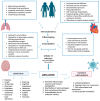Long COVID Syndrome: A Narrative Review on Burden of Age and Vaccination
- PMID: 39200898
- PMCID: PMC11355827
- DOI: 10.3390/jcm13164756
Long COVID Syndrome: A Narrative Review on Burden of Age and Vaccination
Abstract
Background/Objective: The COVID-19 pandemic has led to the emergence of post-acute COVID-19 syndrome, also known as long COVID, which presents a significant challenge due to its varied symptoms and unpredictable course, particularly in older adults. Similar to COVID-19 infections, factors such as age, pre-existing health conditions, and vaccination status may influence the occurrence and severity of long COVID. The objective is to analyze the role of aging in the context of long COVID and to investigate prevalence rates and vaccination efficacy to improve prevention strategies and treatment in this age group. Methods: Four researchers independently conducted a literature search of the PubMed database to trace studies published between July 2020 and July 2024. Results: Aging influences both the likelihood of developing long COVID and the recovery process, due to age-related physiological changes, immune system alterations, and the presence of comorbidities. Vaccination plays a key role in reducing the risk of long COVID by attenuating the inflammatory responses associated with its symptoms. Conclusions: Despite the protection vaccines offer against severe infection, hospitalization, and post-infection sequelae, vaccine hesitancy remains a major obstacle, worsening the impact of long COVID. Promising treatments for this condition include antivirals although further research is needed.
Keywords: COVID-19; aging; long COVID; vaccine.
Conflict of interest statement
The authors declare that they have no conflicts of interest.
Figures
Similar articles
-
COVID-19 pandemic dynamics in India, the SARS-CoV-2 Delta variant, and implications for vaccination.medRxiv [Preprint]. 2021 Nov 22:2021.06.21.21259268. doi: 10.1101/2021.06.21.21259268. medRxiv. 2021. Update in: J R Soc Interface. 2022 Jun;19(191):20210900. doi: 10.1098/rsif.2021.0900. PMID: 34845460 Free PMC article. Updated. Preprint.
-
The Impact of Social Media on Vaccination: A Narrative Review.J Korean Med Sci. 2023 Oct 16;38(40):e326. doi: 10.3346/jkms.2023.38.e326. J Korean Med Sci. 2023. PMID: 37846789 Free PMC article. Review.
-
The Rapid Development and Early Success of Covid 19 Vaccines Have Raised Hopes for Accelerating the Cancer Treatment Mechanism.Arch Razi Inst. 2021 Mar;76(1):1-6. doi: 10.22092/ari.2021.353761.1612. Epub 2021 Mar 1. Arch Razi Inst. 2021. PMID: 33818952 Free PMC article.
-
Perceptions and Concerns Regarding COVID-19 Vaccination in a Military Base Population.Mil Med. 2022 Oct 29;187(11-12):e1255-e1260. doi: 10.1093/milmed/usab230. Mil Med. 2022. PMID: 34117501 Free PMC article.
-
Long COVID: A Systematic Review of Preventive Strategies.Infect Dis Rep. 2025 May 21;17(3):56. doi: 10.3390/idr17030056. Infect Dis Rep. 2025. PMID: 40407658 Free PMC article. Review.
Cited by
-
From Stagnation to Strategy: Challenges in Advancing Long COVID Research.J Eval Clin Pract. 2025 Aug;31(5):e70180. doi: 10.1111/jep.70180. J Eval Clin Pract. 2025. PMID: 40801304 Free PMC article.
References
-
- COVID-19 Deaths|WHO COVID-19 Dashboard. Datadot. [(accessed on 5 February 2024)]. Available online: https://data.who.int/dashboards/COVID19/cases.
-
- Soriano J.B., Murthy S., Marshall J.C., Relan P., Diaz J.V., WHO Clinical Case Definition Working Group on Post-COVID-19 Condition A clinical case definition of post-COVID-19 condition by a Delphi consensus. Lancet Infect. Dis. 2022;22:e102–e107. doi: 10.1016/S1473-3099(21)00703-9. - DOI - PMC - PubMed
-
- Fernández-de-Las-Peñas C., Palacios-Ceña D., Gómez-Mayordomo V., Florencio L.L., Cuadrado M.L., Plaza-Manzano G., Navarro-Santana M. Prevalence of post-COVID-19 symptoms in hospitalized and non-hospitalized COVID-19 survivors: A systematic review and meta-analysis. Eur. J. Intern. Med. 2021;92:55–70. doi: 10.1016/j.ejim.2021.06.009. - DOI - PMC - PubMed
Publication types
LinkOut - more resources
Full Text Sources



